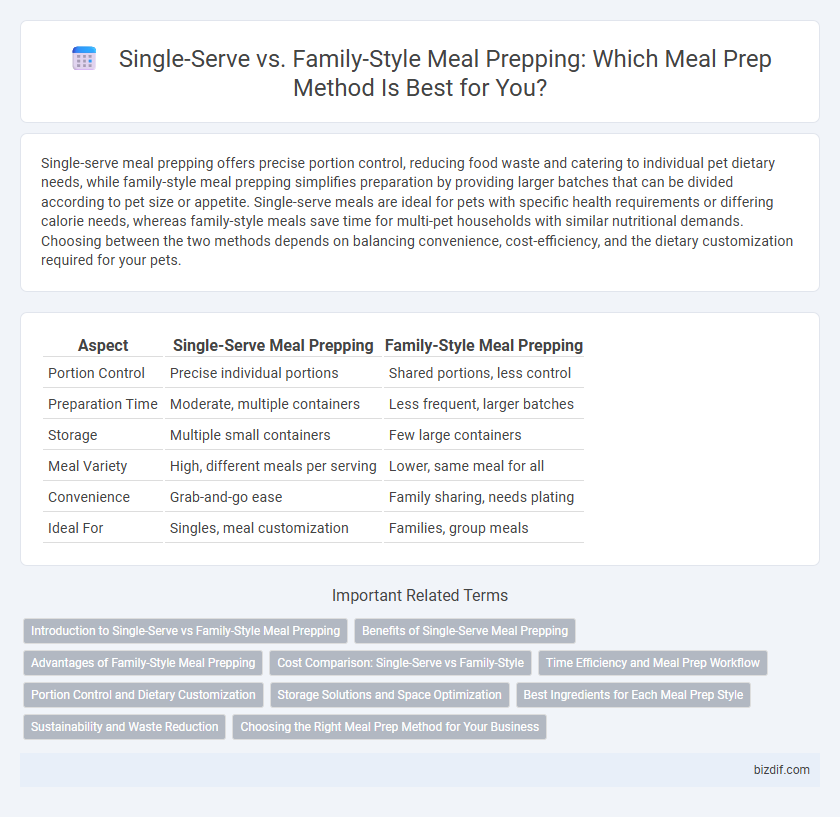Single-serve meal prepping offers precise portion control, reducing food waste and catering to individual pet dietary needs, while family-style meal prepping simplifies preparation by providing larger batches that can be divided according to pet size or appetite. Single-serve meals are ideal for pets with specific health requirements or differing calorie needs, whereas family-style meals save time for multi-pet households with similar nutritional demands. Choosing between the two methods depends on balancing convenience, cost-efficiency, and the dietary customization required for your pets.
Table of Comparison
| Aspect | Single-Serve Meal Prepping | Family-Style Meal Prepping |
|---|---|---|
| Portion Control | Precise individual portions | Shared portions, less control |
| Preparation Time | Moderate, multiple containers | Less frequent, larger batches |
| Storage | Multiple small containers | Few large containers |
| Meal Variety | High, different meals per serving | Lower, same meal for all |
| Convenience | Grab-and-go ease | Family sharing, needs plating |
| Ideal For | Singles, meal customization | Families, group meals |
Introduction to Single-Serve vs Family-Style Meal Prepping
Single-serve meal prepping offers personalized portion control, making it easier to manage dietary needs and reduce food waste. Family-style meal prepping emphasizes bulk cooking and shared servings, fostering communal eating and simplifying preparation for multiple people. Choosing between these methods depends on lifestyle preferences, nutritional goals, and household size.
Benefits of Single-Serve Meal Prepping
Single-serve meal prepping offers precise portion control, reducing food waste and supporting weight management goals. It enhances convenience for busy schedules by allowing quick, grab-and-go meals tailored to individual dietary preferences and nutritional requirements. This method also simplifies tracking calorie and macronutrient intake, promoting healthier eating habits.
Advantages of Family-Style Meal Prepping
Family-style meal prepping offers significant advantages such as reducing overall cooking time and minimizing kitchen cleanup by preparing larger, shared dishes. It promotes portion control and reduces food waste through bulk cooking, making it cost-effective for households. This method encourages communal dining and flexibility in meal portions, accommodating diverse dietary preferences within the family.
Cost Comparison: Single-Serve vs Family-Style
Single-serve meal prepping often incurs higher costs due to increased packaging, portioning, and ingredient variety needed for individual meals. Family-style meal prepping reduces per-serving expenses by utilizing bulk purchases and larger portions, maximizing ingredient efficiency and time savings. Choosing family-style meal prepping can significantly lower weekly grocery bills and minimize food waste compared to single-serve preparations.
Time Efficiency and Meal Prep Workflow
Single-serve meal prepping maximizes time efficiency by allowing precise portion control and streamlined cooking processes, reducing overall preparation and cleanup time. Family-style meal prepping tends to require longer cooking sessions and more complex workflow coordination but benefits from batch cooking and shared serving, optimizing meal variety and quantity. Choosing between these methods depends on balancing individual convenience with bulk preparation strategies to enhance meal prep workflow.
Portion Control and Dietary Customization
Single-serve meal prepping enhances portion control by providing individually measured meals, reducing the risk of overeating and supporting personalized dietary goals. Family-style meal prepping promotes flexibility, allowing members to customize their plates based on specific nutritional needs and preferences. Both approaches facilitate balanced nutrition, but single-serve excels in precise calorie management while family-style encourages shared variety and adaptability.
Storage Solutions and Space Optimization
Single-serve meal prepping utilizes compact, portion-controlled containers that maximize fridge and freezer space, making it easier to organize and access individual meals. Family-style meal prepping often requires larger, stackable containers designed to optimize storage by consolidating multiple servings, reducing clutter and streamlining meal access for groups. Both methods benefit from airtight, modular containers that preserve food freshness while enhancing space efficiency in kitchen storage.
Best Ingredients for Each Meal Prep Style
Single-serve meal prepping thrives on portion-controlled ingredients such as lean proteins, pre-cut vegetables, and whole grains that ensure balanced, individualized nutrition. Family-style meal prepping benefits from versatile staples like large cuts of meat, bulk foods like rice and pasta, and versatile vegetables that can be easily shared and customized at the table. Selecting nutrient-dense, shelf-stable ingredients enhances convenience and maintains freshness across both meal prep styles.
Sustainability and Waste Reduction
Single-serve meal prepping minimizes food waste by allowing precise portion control and reducing leftovers, making it ideal for sustainable consumption. Family-style meal prepping promotes bulk cooking and shared servings, which can lead to efficient use of ingredients but may cause more food waste if portion sizes are not well managed. Choosing between these meal prepping styles depends on household size and consumption patterns to optimize sustainability and minimize food waste.
Choosing the Right Meal Prep Method for Your Business
Single-serve meal prepping offers precise portion control and convenience, ideal for businesses targeting busy individuals or health-conscious consumers seeking customized meals. Family-style meal prepping, on the other hand, maximizes efficiency and reduces packaging waste, catering effectively to larger households or communal dining experiences. Selecting the right meal prep method depends on understanding your target market's preferences, delivery logistics, and scalability requirements.
Single-serve meal prepping vs family-style meal prepping Infographic

 bizdif.com
bizdif.com